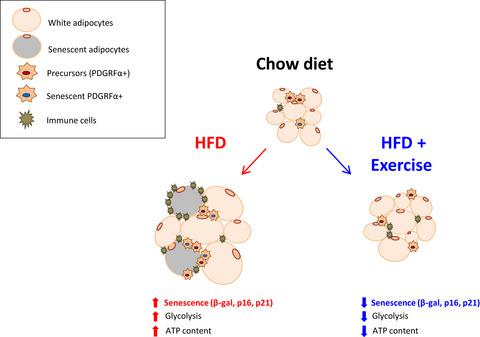当前位置:
X-MOL 学术
›
Aging Cell
›
论文详情
Our official English website, www.x-mol.net, welcomes your feedback! (Note: you will need to create a separate account there.)
Adipose tissue senescence is mediated by increased ATP content after a short-term high-fat diet exposure
Aging Cell ( IF 7.8 ) Pub Date : 2021-07-18 , DOI: 10.1111/acel.13421 Maria Pini 1, 2 , Gabor Czibik 1, 2 , Daigo Sawaki 1, 2 , Zaineb Mezdari 1, 2 , Laura Braud 2 , Thaïs Delmont 1, 3 , Raquel Mercedes 2 , Cécile Martel 4 , Nelly Buron 4 , Geneviève Marcelin 5 , Annie Borgne-Sanchez 4 , Roberta Foresti 2 , Roberto Motterlini 2 , Corneliu Henegar 2 , Geneviève Derumeaux 1, 2
Aging Cell ( IF 7.8 ) Pub Date : 2021-07-18 , DOI: 10.1111/acel.13421 Maria Pini 1, 2 , Gabor Czibik 1, 2 , Daigo Sawaki 1, 2 , Zaineb Mezdari 1, 2 , Laura Braud 2 , Thaïs Delmont 1, 3 , Raquel Mercedes 2 , Cécile Martel 4 , Nelly Buron 4 , Geneviève Marcelin 5 , Annie Borgne-Sanchez 4 , Roberta Foresti 2 , Roberto Motterlini 2 , Corneliu Henegar 2 , Geneviève Derumeaux 1, 2
Affiliation

|
In the context of obesity, senescent cells accumulate in white adipose tissue (WAT). The cellular underpinnings of WAT senescence leading to insulin resistance are not fully elucidated. The objective of the current study was to evaluate the presence of WAT senescence early after initiation of high-fat diet (HFD, 1–10 weeks) in 5-month-old male C57BL/6J mice and the potential role of energy metabolism. We first showed that WAT senescence occurred 2 weeks after HFD as evidenced in whole WAT by increased senescence-associated ß-galactosidase activity and cyclin-dependent kinase inhibitor 1A and 2A expression. WAT senescence affected various WAT cell populations, including preadipocytes, adipose tissue progenitors, and immune cells, together with adipocytes. WAT senescence was associated with higher glycolytic and mitochondrial activity leading to enhanced ATP content in HFD-derived preadipocytes, as compared with chow diet-derived preadipocytes. One-month daily exercise, introduced 5 weeks after HFD, was an effective senostatic strategy, since it reversed WAT cellular senescence, while reducing glycolysis and production of ATP. Interestingly, the beneficial effect of exercise was independent of body weight and fat mass loss. We demonstrated that WAT cellular senescence is one of the earliest events occurring after HFD initiation and is intimately linked to the metabolic state of the cells. Our data uncover a critical role for HFD-induced elevated ATP as a local danger signal inducing WAT senescence. Exercise exerts beneficial effects on adipose tissue bioenergetics in obesity, reversing cellular senescence, and metabolic abnormalities.
中文翻译:

脂肪组织衰老是由短期高脂肪饮食暴露后增加的 ATP 含量介导的
在肥胖的情况下,衰老细胞在白色脂肪组织 (WAT) 中积累。WAT 衰老导致胰岛素抵抗的细胞基础尚未完全阐明。本研究的目的是评估 5 个月大的雄性 C57BL/6J 小鼠开始高脂饮食(HFD,1-10 周)后早期 WAT 衰老的存在以及能量代谢的潜在作用。我们首先表明 WAT 衰老发生在 HFD 后 2 周,正如在整个 WAT 中通过增加衰老相关的 ß-半乳糖苷酶活性和细胞周期蛋白依赖性激酶抑制剂 1A 和 2A 表达来证明的那样。WAT 衰老影响各种 WAT 细胞群,包括前脂肪细胞、脂肪组织祖细胞和免疫细胞,以及脂肪细胞。与食物来源的前脂肪细胞相比,WAT 衰老与更高的糖酵解和线粒体活性相关,导致 HFD 来源的前脂肪细胞中 ATP 含量增加。在 HFD 后 5 周开始进行为期 1 个月的每日锻炼,这是一种有效的抗衰老策略,因为它可以逆转 WAT 细胞衰老,同时减少糖酵解和 ATP 的产生。有趣的是,运动的有益效果与体重和脂肪量的减少无关。我们证明了 WAT 细胞衰老是 HFD 开始后最早发生的事件之一,并且与细胞的代谢状态密切相关。我们的数据揭示了 HFD 诱导的 ATP 升高作为诱导 WAT 衰老的局部危险信号的关键作用。运动对肥胖中的脂肪组织生物能量学产生有益影响,
更新日期:2021-08-19
中文翻译:

脂肪组织衰老是由短期高脂肪饮食暴露后增加的 ATP 含量介导的
在肥胖的情况下,衰老细胞在白色脂肪组织 (WAT) 中积累。WAT 衰老导致胰岛素抵抗的细胞基础尚未完全阐明。本研究的目的是评估 5 个月大的雄性 C57BL/6J 小鼠开始高脂饮食(HFD,1-10 周)后早期 WAT 衰老的存在以及能量代谢的潜在作用。我们首先表明 WAT 衰老发生在 HFD 后 2 周,正如在整个 WAT 中通过增加衰老相关的 ß-半乳糖苷酶活性和细胞周期蛋白依赖性激酶抑制剂 1A 和 2A 表达来证明的那样。WAT 衰老影响各种 WAT 细胞群,包括前脂肪细胞、脂肪组织祖细胞和免疫细胞,以及脂肪细胞。与食物来源的前脂肪细胞相比,WAT 衰老与更高的糖酵解和线粒体活性相关,导致 HFD 来源的前脂肪细胞中 ATP 含量增加。在 HFD 后 5 周开始进行为期 1 个月的每日锻炼,这是一种有效的抗衰老策略,因为它可以逆转 WAT 细胞衰老,同时减少糖酵解和 ATP 的产生。有趣的是,运动的有益效果与体重和脂肪量的减少无关。我们证明了 WAT 细胞衰老是 HFD 开始后最早发生的事件之一,并且与细胞的代谢状态密切相关。我们的数据揭示了 HFD 诱导的 ATP 升高作为诱导 WAT 衰老的局部危险信号的关键作用。运动对肥胖中的脂肪组织生物能量学产生有益影响,



























 京公网安备 11010802027423号
京公网安备 11010802027423号